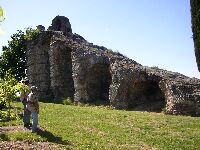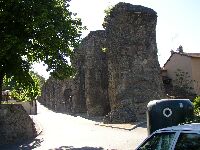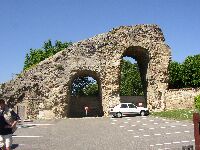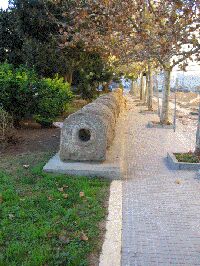




HT = Header tank (left)
RT = Receiving tank (right)
VB = Venter bridge (bottom)
G = Geniculus (bend)
| HOME | More literature on more aqueducts | Last modified: May, 2018 - (W.D. Schram) |
| Reference)* | Short title | Page(s) | Remarks |
|---|---|---|---|
| Alkan 2014 | Inverted siphons in Western Anatolia | 55 - 70 | in: SRdFG vol 29 |
| Amit2002 | Aqueducts in Israel | .... | |
| Bennett2003 | The Remnants of Roman Ancyra | np | Bilkent University Newsletter nr 2 |
| Bestue2006 | Roman siphons in Spain | 311 | In: Cura Aquarum in Ephesus 2006 |
| Biernacka1973 | Waterworks | 280 | |
| Bol1990 | Gadara in der Dekapolis | pag 201 | AA 1990 |
| Bozic2004 | "Talijanova Buza" ..Pag | 28-38 | SdFG vol 26 (2004) |
| Casado1983 | Hidraulica | 487 + 527 table | without lit. ref. |
| Crouch1984 | Morgantina | 356 plus note 22 | in: AJA vol 88 (1984) |
| De Vos Raaijmakers2013 | Rus Africum vol II | 15, 29-32 | site 232 |
| Doring 2016 | Wasser fur die Dekapolis | pag 72-77 | the book |
| Esperou2009 | L'aqueduc Romain de Béziers | 37, 71 | 37 = Beziers, 71 = Causses et Veyran |
| Fahlbusch1982 | Vergleich | 65 | |
| Gajic2014 | Roman military installations | 28 | |
| Galanaki2006 | Management of water resources in Chersonissos | 265 - 270 | In: 1st IWA Integrated symposion on WWWT |
| Garbrecht1982 | Wasserversorgung im antiken Rom | 181-183 | Frontinus series part 1 |
| Garbrecht1994 | Desert Fortresses | 168 | |
| Gaspari2016 | Water in Roman Emona | 65 | bilangual PhD-thesis |
| Hodge1983 | Siphons | 185 n34 | only Roman siphons |
| Hodge1992 | Roman aqueducts | 33 + n49 / 428 n43 | Greek / Roman |
| Ilakovac 2008 | Roman aqueducts on Pag | 130 | |
| Kelly2004 | The Roman aqueducts and bathhouses of Crete | PhD-thesis | |
| Kelly2018 | A Roman aqueduct through the Cretan highlands | 163 | In: G.A. Aristodemou (ed): Great waterworks in Roman Greece |
| Keres2016 | Water systems of Parion | 25 - 31 | In: Proceedings Antalya Conference |
| Kovacic2014 | Anticki vodovod vodovoda | ||
| Lemos2012 | Sistemas de abastecimiento ... Bracara Augusta | pag 55 | PhD-thesis |
| Mazar2001 | Wasserleitungen nach Jerusalem | pag 165 ff | in: Dierx2001 |
| Mazloum1936 | L'ancienne canalisation d'eau d'Alep | Fig 1 | Roman? |
| Mezquiriz1979 | El acueducto de Alcanadre-Lodosa | pag 139 - 147 | not Roman; in: Trabajos de Arqueologia Navarra vol 1 |
| Mezquiriz1988 | De hydraulica romana ...Andelos | pag 288 ff | in: Arqueologia Navarre vol 7 separata |
| MoralesRodriguez2005 | Análisis ...elementos ... de la Yedra (Canena) | pag 365 - 382 | in: Florentia Illiberritana vol 16 (2005) |
| Ozis1996 | Historical water schemes | 362 | In: Water Resources Devel vol 12-3 |
| Smith1976 | Attitudes | 52 / 54 | Greek / Roman |
| Stenton1986 | Oenoanda | 23+24 n33 | |
| Tanriöver2006 | Water Supply in Caria | 127 | in: Cura Aquarum in Ephesus 2006 |
| Tolle-Kastenbein1990 | Wasserkultur | 75 ff | |
| Van Buren1955 | Druckrohrleitungen | 472ff | In: Wissowa RE |
| Weber1898, 1899,1904/5 | Kleinasiatischen Stadte | incl. Smyrna and Laodicea | |
| Wilson2012 | The aqueduct of Butreint | pag 77 - 96 | In: Butrint 4 |
| Name | Country | Material | Length (m) | Height (m) | Date | Literature source | Remarks |
|---|---|---|---|---|---|---|---|
| France | |||||||
| Arles - ARELATE | France | lead pipes | Genier 1960 p85 Hodge1983 p189 |
crossing the river Rhone | |||
| Bavay - BAGACUM | France | 1000-1700 | 15-25 | Jolin1955 | See also website | ||
| Causses-et-Veyran | France | lead pipes | 400 | 17 | unknown | Esperou 2009,71-75 | Series of 6 consecutive siphons |
| Lyon-Mont d'Or-Limonest - LUGDUNUM | France | lead pipes | 420 | 30 | mid 1 c BC | Burdy1987 | See our own website |
| Lyon-Mont d'Or-des Plances | France | lead pipes | 3500 | 70 | mid 1 c BC | Burdy1987 | |
| Lyon-l'Yzeron-Craponne | France | lead pipes | 2200+3600 | 33+91 | end 1 c BC or early 1 c AD | Burdy1991 | double siphon |
| Lyon-Brévenne-Ecully/Tassin | France | lead pipes | 3500 | 90 | early 1 c AD | Burdy1993 | |
| Lyon-Brévenne-Lyon? | France | lead pipes | 500 | 20 | early 1 c AD | Burdy1993 | |
| Lyon-Gier-Genilac | France | lead pipes | 700 | 79 | mid 1 / early 2nd c AD | Burdy1996 | |
| Lyon-Gier-Le Garon | France | lead pipes | 1210 | 93,5 | mid 1 / early 2nd c AD | Burdy1996 | |
| Lyon-Gier-L'Yzeron | France | lead pipes | 2660 | 122,3 | mid 1 / early 2nd c AD | Burdy1996 | |
| Lyon-Gier-Trion | France | lead pipes | 575 | 38 | mid 1 / early 2nd c AD | Burdy1996 | |
| Rodez - SEGODUNUM | France | lead pipes? | 100 | Grenier1960 p153 | |||
| Saintes - MEDIOLANTM SANTONUM | France | 2500 | 10-12 | early 1c AD | Triou1968 pag 125-127 Hodge1983 p192 |
mainly based on topographical evidence | |
| Vienne - VIENNA | France | lead pipe | 2 / early 3 c AD | Pelletier2001 | crosing the river Rhone | ||
| Greece | |||||||
| Chersonissos - CHERSONASOS | Crete, Greece | Galanaki 2006; Kelly2004,2018,163 | Galanaki: 'likely'; reference is made to Oikonomakis 1984, 87 | ||||
| Gortis / GORTYNA (2x) | Crete, Greece | Kelly2004,2018,163 | |||||
| Knossos - Col JULIA NOBILIS CNOSOS | Crete, Greece | Kelly2004,2018,163 | pre-Roman | ||||
| Lyttos - LYKTOS | Crete, Greece | Kelly2004,2018,163 | |||||
| Mithimna on Lesbos - METHYMNA | Greece | stone or stone/clay | Hellenistic | Buchholz1975 p57/58 Merckel1899 p506 Koldewey1890?? |
|||
| Palaio-Preveza - NICOPOLIS | Greece | Tolle1990 based on Leake 1835 | |||||
| Archaia Olympia - OLYMPIA | Greece | lead pipes | Merckel1899 p496 Tolle citing Graber1892 |
||||
| Nea Olynthos - OLYNTHOS | Greece | clay pipes | 10 | Hellenistic | Tolle1990 Crough1993 p71-75 (from Wik p647) |
||
| Pythagorion - SAMOS | Greece | stone pipes | Hellenistic | Tolle1990 based on Tolle: Samos XIV (1974) p53ff | |||
| Israel | |||||||
| Sartaba - ALEXANDREION | Israel | masonry + slabs (!) |
190 | 110 | 1 c BC | Garbrecht 1994 | |
| Tiberias - TIBERIAS (branch Beth Yerah) | Israel | basalt pipes | 50 | Amit2002 | side branche of the aqueduct to Tiberias |
||
| Jerusalem - IERUSALEM | Israel | Amit2002 | |||||
| Samaria - SEBASTE | Israel | stone pipe | Amit2002 | ||||
| Susita - HIPPOS | Israel | stone pipe | Fahlbusch1997 Amit2002 |
||||
| Italy | |||||||
| Agrigento - AKRAGAS | Italy | Greek | Crouch1984 pag 356 n22 | probably | |||
| Luco dei Marsi - ANGITIAE LUCUS | Italy | masonry + slabs (!) |
1rst c AD | Blake1959 p82 Giovannoni1935 p70 |
|||
| Alatri - ALETRIUM | Italy | moulded or casted lead pipes | 3000 | 101 | 2nd c BC | Montauzan1908 pag 194-197 Tolle1990 from Bassel1881 Hodge1983 p192 + n54 |
Bassel1919?? |
| Catania - KATINA | Italy | Wilson2000b pag 25 | San Venera al Pozzo near Catania | ||||
| Serra Orlando - MORGANTINA | Italy | Greek | Crouch1984 pag 356 | ||||
| Rome-Anio Vetus- ROMA | Italy | Van Deman1934 pag 61 | just below Ponte Lupo | ||||
| Rome-Aqua Marcia | Italy | lead pipes | Status Silv 1,3 66-67 [H92] Van Deman1934 pag 61?? |
at Tibur under the river Anio to the villa of Manlius Vopiscus | |||
| Rome-Aqua Marcia | Italy | lead pipes?? | 140 BC | Ashby1935 p152 Van Deman p139 |
to the Capitol | ||
| Rome-Aqua Claudia | Italy | lead pipes?? | Ashby1935 p249-251 Van Deman pag 267 Blake1959 p123n95 Winslow ?? |
to the Palatine (with doubts) | |||
| Syracuse - SYRACUSA | Italy | Greek | Crouch1984 pag 356 n22 | probably | |||
| Termini Imerese - THERMAE HIMERAEAE | Italy | lead pipes | 1300 | 40 | Belvedčre1986,2000 | Barratina and Tre Pietre | |
| Spain / Portugal | |||||||
| Alcanadre Lodosa |
Spain | series of lead pipes ? | Casado1972 (p193) Casado1983 p510+516 Hodge1983 p191 Mezquiriz1979 |
1) This bridge is not Roman, 2) is not for Calahorra, 3) and has no siphon. See our website |
|||
| Muruzabal de Andion / ANDELOS |
Spain | lead pipes ? | Mezquiriz1988 | doubtful | |||
| Almuñécar SEXI |
Spain | terracotta pipes | 1100 | 38 | Roman | Casado1972 (p149) Casado1983 p488, p508 Hodge1983 p190 n50+51 Bestue2006 |
See our own website |
| Braga BRACARA AUGUSTA |
Portugal | stone pipe | Lemos 2012 | ||||
| Cadiz - GADEZ | Spain | stone pipes | Casado1972 (p162) Bestue2006 PerezMarrero2012 |
Two siphons in series. See our own website See also: AQVA DVCTA |
|||
| Canena - .... | Spain | stone pipes ? | MoralesRodriguez2005 | ||||
| Segóbriga Saelices - SEGOBRIGA | Spain | 20 | Casado1983 p515-520 Bestue2006 |
||||
| Toledo - TOLETUM | Spain | Casado1983 p514 Alonso1997 Bestue2006 |
uncertain, little remains. (venter?) bridge with 1,2 or 3 orders with or without siphon | ||||
| Zaragoza - CAESARAUGUSTA | Spain | Bestue2006 | |||||
| Turkey | |||||||
| Ahat Koy - AKMONIA | Turkey | stone pipes | 15-25 | Hellenistic / early Roman | Weber1904 | ||
| 2.Doganyurt - ALABANDA | Turkey | stone blocks | Alkan 2014 | ||||
| Karpuziu/Demircideresi - ALINDA | Turkey | clay pipes | Tanriover2006 | ||||
| Ankara - ANCYRA | Turkey | stone pipes | Flavian date? | Bennett2003 | |||
| Aliagaciftligi - Antiochia on the Meander | Turkey | clay pipes | 15 | Hellenistic | Weber1904 | ||
| Yalvac - Antiochia in Pisidia | Turkey | stone pipes | 28 | early 1c AD | Weber1904 Burdy1997 |
||
| Dinar - APAMEA / KITOBOS | Turkey | stone pipes | 28 | early Roman? | Weber1904 | ||
| Aspendos - ASPENDUS | Turkey | stone pipes | 1670 | 45 | Roman 2c AD | Ward-Perkins1955 p115-123 Kessener1998a, 1998b, 2000, 2001b, 2004 |
double siphon |
| Sulmenli - BLAUNDOS | Turkey | clay pipes | 15 | early Roman? | Weber1904 | ||
| Girme - CREMNA | Turkey | terracotta pipes | 300 | ? | Owens1991 | ||
| Horzum - CIBYRA | Turkey | stone blocks | Alkan 2014 | ||||
| Selcuk - EPHESUS / EPHESOS | Turkey | lead pipes in stone sockets | archaic / classical | Bammer1972 p714-728 Ozis1996 |
|||
| near Ovacik - GERGA | Turkey | stone pipes | unknown | Ozis1996 | |||
| Pamukkele - HIERAPOLIS | Turkey | clay pipes | Tanriover2006 | ||||
| Eski-Hisar - LAODICEA AD LYCUM | Turkey | stone pipes | 800-1000 | 25-50 | early Roman | Weber1898, Ozis1996 | |
| Manisa - MAGNESIA AD SIPYLUM | Turkey | clay pipes | 30 | early Roman | Weber1904 | ||
| Milas - MYLASA ?? | Turkey | S76 dus Merckel/vBuren?? | |||||
| Milete - MILETUS | Turkey | clay pipes | Tuttahs | ||||
| Insealiler - OENOANDA | Turkey | stone pipes | 500 | 22 | 1c AD | Stenton1986 | |
| Kemer - PARION | Turkey | stone pipes | Keles 2016 | ||||
| Gelemis - PATARA | Turkey | stone pipes | 260 | 20 | early Roman | Hodge 1983 n34 Hodge1992 p33+n49 Ozis1996 Merckel1899 p504-6 |
|
| Bergama - PERGAMON-Madradag | Turkey | lead pipes | 3250 | 201 | 1rst half 2c AD | Garbrecht1992 Ozis1996 |
Greek and Roman |
| PERGAMON-Selinus / Attalos | Turkey | clay pipes | 25-30 | 200 BC | Garbrecht1992 Ozis1996 |
||
| PERGAMON-Selinus / Demophon | Turkey | clay pipes | 25-30 | 200 BC | Garbrecht1992 Ozis1996 |
||
| Alesehir - PHILADELPHIA | Turkey | clay pipes | 20 | Hellenistic | Weber1904 | ||
| Sulum - PRYMESSOS | Turkey | stone pipes | 40 | Hellenistic | Weber1904 | with doubts | |
| Izmis - SMYRNA | Turkey | stone pipes | 3800 | 158 | Hellenistic + Roman | Weber1899 + 1904 p95 | |
| Ayden - TRALLEIS | Turkey | stone pipes | 75 | early Roman? | Weber1904 | ||
| Boli - TRAPEZOPOLIS | Turkey | stone pipes ? | 40 | early Roman? | Weber1904 | ||
| near Yenice - TRIPOLIS AD MEANDRUM | Turkey | ?? | Tanriover2006 | ||||
| United Kingdom | |||||||
| Caerwent - VENTA SILURUM | United Kingdom | wooden pipes | Burgers2001 based on Hansen1970 p85 | ||||
| Chester - DEVA | United Kingdom | earthenware pipes | Stephens 1985 p60 | ||||
| Colchester - CAMULODUNUM | United Kingdom | wood | Gajic2014 | near Gosbeck cultural center | |||
| Lincoln - Col. LINDUM | United Kingdom | ceramic pipes | Thompson1955 pag 122 Smith 67 n37 |
with doubts water lifted + siphon? |
|||
| Other | |||||||
| Butrint - BOUTHROTUM | Albania | Wilson 2012 | |||||
| Constantina - CIRTA | Algeria | Gsell1901 pag 252 Wilson1997 |
2x, possibly 3x | ||||
| Annaba / Bone - HIPPO REGIUS | Algeria | Wilson 1997 n 278 | probably | ||||
| Plovdiv - PHILIPPOPOLIS | Bulgaria | Biernacka1973 p280 | |||||
| Svishtov - NOVAE | Bulgaria | Biernacka1973 p280 | |||||
| Zadar - IADER | Croatia | Bozic2004 | |||||
| Caska (on Pag island) - CISSA | Croatia | lead | unknown | Ilakovac 2008 | |||
| Cavtat - EPIDAURUM | Croatia | lead | Augustan | Kovacic 2014 | |||
| Sisak - SISCISA | Croatia | Gaspari2016 | |||||
| Der'a - ADRAA (Gadara aq) | Jordan | Bol1990, Doring2016 p74 | double siphon in branch to baths | ||||
| Aleppo - BARAEA | Syria | Mazloum1936 fig 1 | |||||
| Tadmor - PALMYRA | Syria | Garbrecht1982 | Mazar2001 refers to Stenton 1986 | ||||
| Dougga - THUGGA | Tunisia | stone blocks | De Vos Raaijmakers2013 | also Carton1893, 1897 | |||
| Uncertain | |||||||
| Qalaat el-Mouelle - APAMEA (2x) | Syria | Mazar2001 | refers to Stenton 1986 | ||||
| Béziers - Col. BAETERRAE | France | Esperou2009 | in the Puech Noyé branch | ||||
| Rodovani - ELYROS | Crete, Greece | Kelly2018; also Kelly2004 | Refering to Christodoulakos 2011 (non-vidi) | ||||
| HOME | More literature on more aqueducts | Last modified: May, 2018 - (W.D. Schram) |